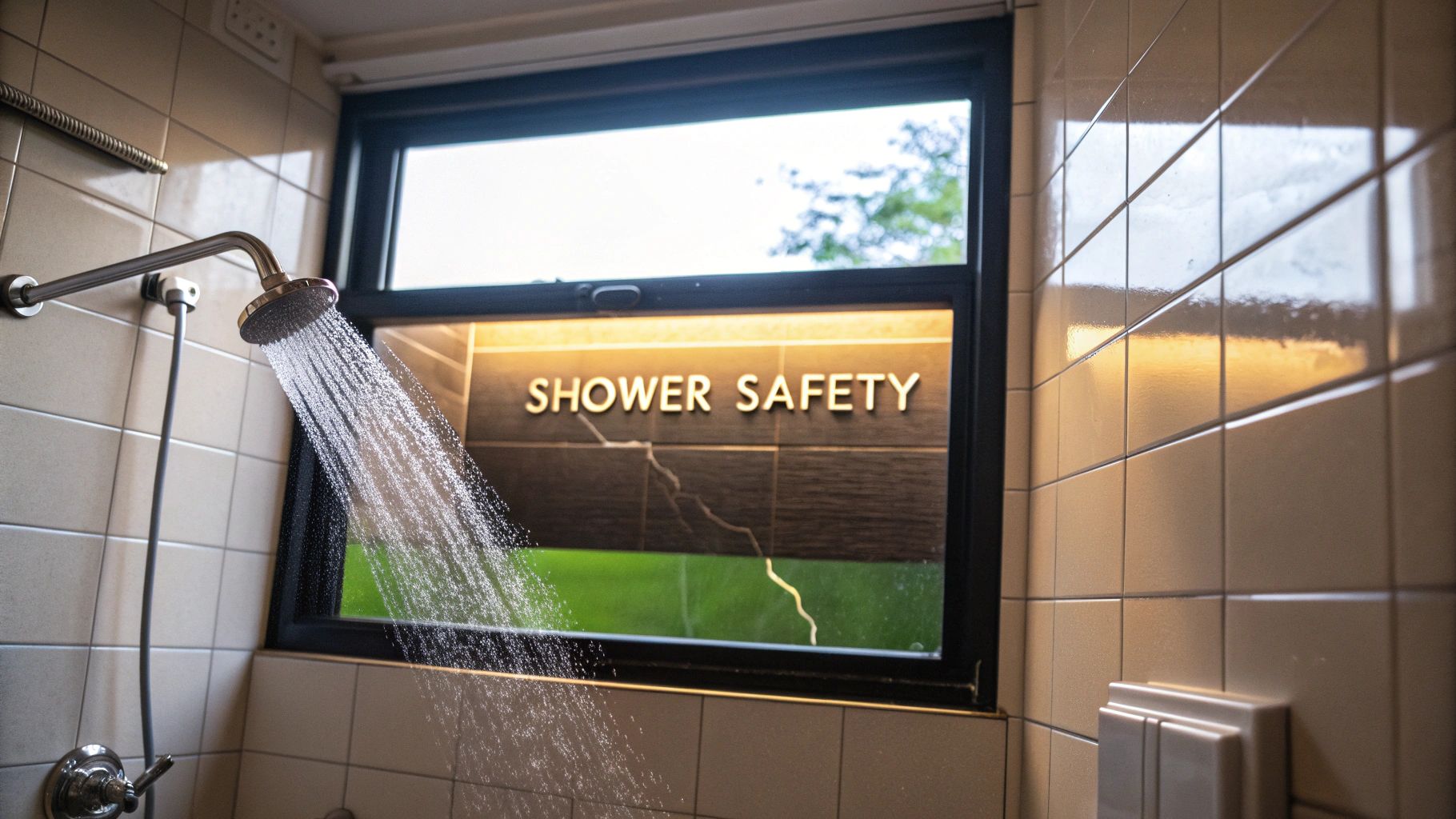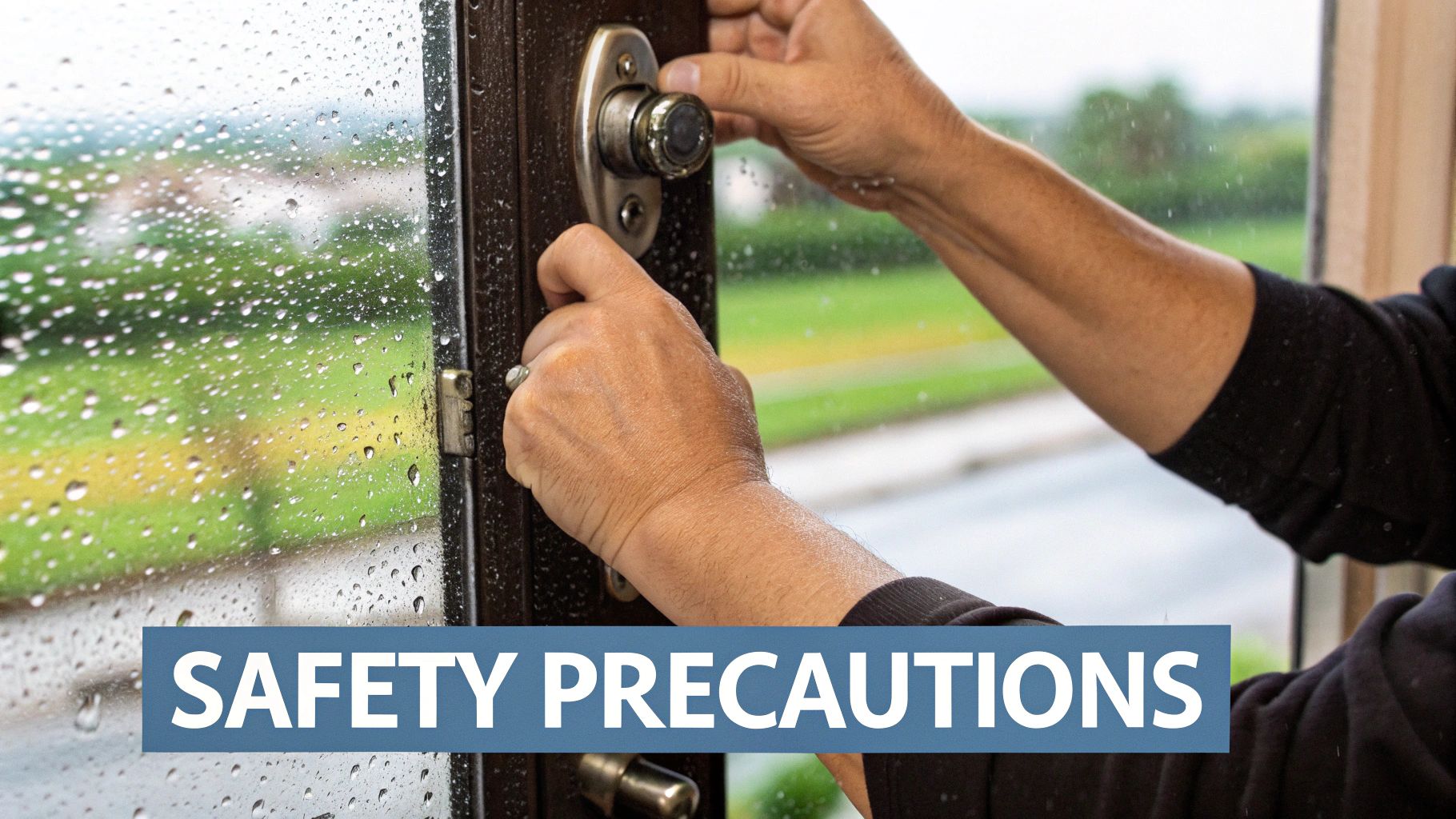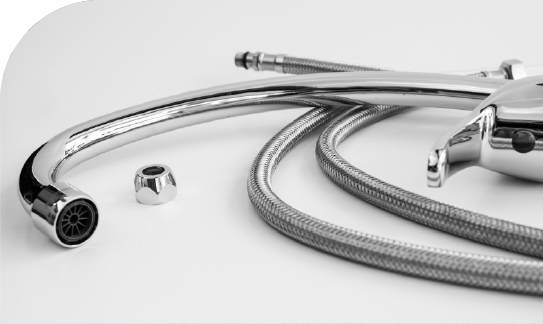您的购物车目前是空的!

Is It Safe to Take a Shower During a Thunderstorm? The Truth
The Hidden Dangers Lurking in Your Safe Haven
Your home feels like the ultimate refuge during a storm, a solid barrier against the raging weather outside. But what if some of the most common household activities could unwittingly invite danger indoors? The question of whether it is safe to take a shower during a thunderstorm isn't just an old wives' tale; it's a serious concern rooted in the fundamental principles of electricity.
Lightning is a massive burst of electrical energy, and it's always looking for the quickest and easiest path to the ground. Unfortunately, your home is filled with these super-conductive pathways.
How Lightning Invades Your Home
It’s easy to think that being inside makes you completely safe. While a building offers great protection from a direct strike, it doesn’t create an impenetrable forcefield. The electrical current from a nearby lightning strike can travel through any conductive material connected to your house, turning your personal sanctuary into a temporary electrical hazard zone.
Think of your home as being plugged into the outside world through a web of wires and pipes. Lightning can take advantage of these connections in several ways:
- Power Lines and Utility Wires: A strike on or near a utility pole can send a massive surge of electricity directly into your home's wiring.
- Phone and Cable Lines: Just like power lines, these cables can serve as a highway for an electrical surge.
- Plumbing Systems: This is the most overlooked danger. Metal pipes running from your home and deep into the ground create a direct, conductive superhighway for lightning.
This illustration shows exactly how the electrical charge from a ground strike can spread out and enter a house through its plumbing and electrical systems, presenting a real indoor threat.
The Scale of the Threat
This danger is more than just a theory. Annually, the United States experiences 25 to 40 million cloud-to-ground lightning strikes. While the number of fatalities is relatively low—averaging around 21 to 27 per year—the risk of serious injury from an indoor electrical shock during a storm is very real and often underestimated. You can find more details on these lightning safety statistics from the Centers for Disease Control and Prevention (CDC).
This is precisely why experts warn against any activity that puts you in contact with these conductive networks. Taking a shower connects you directly to two of them: the water and the metal pipes of your plumbing. The complex network of pipes, especially in older homes with extensive copper plumbing, essentially acts like an accidental lightning rod.
Even the fixtures themselves, like the faucet and showerhead, are part of this conductive path. Understanding how these systems are put together is key to staying safe. For instance, learning more about your home's fixtures, like in this guide on installing a bathroom faucet, can help you see just how interconnected everything is. These entry points turn an abstract warning into concrete, life-saving knowledge.
Why Water Becomes Lightning's Best Friend
To understand why taking a shower during a thunderstorm is unsafe, we need to look at what's actually in your tap water. It’s a common myth that all water is a fantastic electrical conductor. In reality, pure, distilled water is a surprisingly poor conductor. If you imagine lightning as a traveler, pure water would be a rough, unpaved road—very difficult to travel on. The water flowing from your showerhead, however, is a different story entirely.
Your tap water is far from pure. It’s full of dissolved minerals and salts like calcium, magnesium, and sodium. These tiny, invisible particles are known as ions, and they carry an electrical charge. When these ions are present, they transform water into an excellent electrical highway. Think of the minerals as paving crews turning that rough, unpaved road into a multi-lane superhighway for electricity. The more minerals in the water, the more lanes open for the electrical current to zoom along. This is the critical difference between the water in a science lab and the water in your home.
The Path of Least Resistance
Lightning operates on a simple, universal principle: it always seeks the path of least resistance to reach the ground. When a bolt of lightning strikes near your home, it instantly assesses all possible routes and will always choose the easiest one.
This infographic compares the electrical conductivity of air, your tap water, and the metal pipes inside your walls.

As you can see, tap water is thousands of times more conductive than air, and metal is millions of times more conductive than that. This combination creates a dangerously efficient pathway for electricity to travel.
To better understand how different types of water conduct electricity, let's compare them. The table below shows the conductivity levels for various water types you might find in and around your home.
Electrical Conductivity Comparison: Different Water Types
Comparison of electrical conductivity levels in various types of water found in homes
| Water Type | Conductivity Level | Lightning Risk | Common Sources |
|---|---|---|---|
| Pure/Distilled Water | Very Low | Extremely Low | Laboratories, steam irons |
| Rainwater | Low | Low (but can increase) | Direct rainfall, puddles |
| Tap Water | High | High | Faucets, showers, toilets |
| Groundwater/Well Water | Very High | Very High | Private wells, sprinklers |
| Saltwater | Extremely High | Extremely High | Oceans, saltwater pools |
As the table shows, the water in your pipes has a significantly higher conductivity level than pure water, making it a much more attractive path for lightning.
The Perfect Storm of Conductivity
So, when you step into the shower during a thunderstorm, you are unintentionally creating a perfect conductive circuit. You are standing in a stream of mineral-rich water that is in direct contact with metal fixtures—the showerhead and drain. These fixtures are connected to a sprawling network of metal pipes.
These pipes often run through the ground outside your house, providing a direct connection from the storm straight to your bathroom. You become the final, vulnerable link in this highly conductive chain. An electrical charge from a nearby strike can travel from the ground, up through the plumbing system, into the stream of water, and directly through you.
It's not about being directly struck by lightning from the sky; it's about being connected to a system that acts as a lightning magnet. This is why the simple, relaxing act of showering becomes one of the riskiest indoor activities during a thunderstorm, turning your moment of peace into a potential point of contact with thousands of volts of electricity.
Your Plumbing System: An Accidental Lightning Rod Network
Most people see their plumbing as a simple system for moving water around the house. But during a thunderstorm, this network of pipes can become something far more dangerous: an accidental lightning rod. Your home's plumbing is an intricate web of conductive materials that creates a direct highway for lightning's immense electrical power, leading it from outside straight into your bathroom. The answer to "is it safe to take a shower during a thunderstorm" becomes much clearer when you see your pipes not just as water carriers, but as electrical conduits.
Think about a direct strike or even a nearby ground strike. The electricity doesn't just stop where it hits; it spreads through the soil, always looking for the easiest path to travel. Metal pipes buried underground offer a perfect route. This powerful current can surge through your entire plumbing system, energizing every connected pipe, faucet, and fixture in its path.
This visual from the National Fire Protection Association shows how a ground strike can travel into a home through its utilities, including the plumbing system.

The image makes it clear that the danger isn't just from a direct hit to your roof. A strike on the ground nearby can turn your plumbing into a hidden entry point for thousands of volts of electricity.
The Role of Different Plumbing Materials
The type of pipes in your home plays a big part in how easily electricity can travel through them. While some materials are more conductive than others, none offer complete protection from a lightning strike.
- Copper Pipes: Copper is an excellent electrical conductor. Homes with copper plumbing essentially have a highly efficient, continuous metal path from the ground directly to your faucets and showerhead. This makes them particularly good at carrying a dangerous electrical charge.
- Plastic (PVC/PEX) Pipes: Modern plastic plumbing is often thought to be safer because plastic itself is a poor conductor of electricity. However, this does not make you safe. The water flowing inside the plastic pipes is still highly conductive due to its mineral content. Furthermore, your fixtures—like the showerhead, drain, and valve handles—are almost always made of metal. These metal parts can still become energized if lightning finds a path, either through the water itself or via the home's grounding system, which is often bonded to the plumbing.
Your entire plumbing system, including critical parts like valves, can become a conduit for electricity. Properly understanding your home's water flow control valve system shows just how many metallic components are involved in managing water. Even behind the walls, the inner workings, as seen when you look into shower valve rough-in dimensions, reveal a complex assembly of metal pieces all connected to this vast network.
When Lightning Strikes Home: Real Stories, Real Consequences

The warnings about lightning safety aren't just abstract advice; they are rooted in harrowing, real-life events. These stories are not urban legends but documented cases that make the question, “is it safe to take a shower during a thunderstorm?” feel intensely personal. The accounts of survivors offer a stark look at what happens when a routine indoor activity meets a powerful storm, often with life-altering results.
Consider a documented case where a person was knocked unconscious while simply doing the dishes during a thunderstorm. Lightning struck near their home, and the immense electrical charge traveled through the plumbing. The current exited through the metal sink faucet and the stream of water, throwing the individual across the room and causing significant burns. This incident underscores a critical point: any contact with water connected to plumbing—showering, washing hands, or doing dishes—presents a similar danger.
The Common Threads in Indoor Strikes
These real-world examples reveal a few common threads that connect these dangerous encounters. The circumstances are almost always ordinary, happening in what feels like the complete safety of one's home. The timing is a matter of a split second, a moment of terrible luck where a person unknowingly becomes a link in a powerful electrical circuit.
The consequences, however, can be devastating and long-lasting. Survivors often report not just physical injuries like burns and muscle damage, but also long-term neurological issues, including memory problems and chronic pain.
While official data provides a broad overview, these individual accounts truly drive the point home. Statistics from the Centers for Disease Control and Prevention (CDC) show that about a third of all lightning-strike injuries happen indoors. These injuries aren't from direct strikes but from electrical current traveling through a home's conductive systems, like wiring and plumbing.
To better understand these risks, the table below breaks down the most common activities that lead to indoor lightning injuries.
Indoor Lightning Injury Statistics by Activity
Breakdown of lightning-related injuries that occur indoors, categorized by the activity being performed
| Activity | Percentage of Indoor Injuries | Severity Level | Most Common Injuries |
|---|---|---|---|
| Using Corded Electronics | 29% | Moderate to Severe | Shock, burns, cardiac arrest |
| Contact with Plumbing | 21% | Severe | Shock, burns, loss of consciousness |
| Touching Metal Doors/Windows | 16% | Low to Moderate | Minor shock, numbness |
| Leaning on Concrete Walls | 4% | Low to Moderate | Shock, tingling sensations |
As the data shows, contact with plumbing is the second leading cause of indoor lightning injuries, accounting for 21% of incidents and often resulting in severe consequences.
Each story and every statistic reinforces the same vital message: simple precautions are based on real-world evidence. Heeding these warnings isn't about being overly anxious—it's about respecting the proven power of nature and taking sensible steps to stay safe.
Expert-Backed Safety Strategies That Actually Work
When the sky darkens and thunder rumbles, knowing what to do—and what not to do—can make all the difference. The advice from meteorologists, electrical engineers, and emergency responders is straightforward and consistent: avoid contact with plumbing and electrical systems during a thunderstorm. But what does that mean in practice? Here are some proven, time-tested strategies that professionals rely on to keep their homes and families safe.
The Gold Standard: The 30-30 Rule
One of the most effective and widely used safety guidelines is the 30-30 rule. Think of it as a simple, two-step method for judging lightning's distance and figuring out when it's truly safe to get back to your day.
-
The First 30 (Seconds): When you see a lightning flash, start counting the seconds until you hear the thunder. If you count 30 seconds or less, the storm is within six miles of you—close enough to pose an immediate danger. At this point, you should already be inside a sturdy, enclosed shelter, away from windows, doors, and anything connected to your home's wiring or plumbing.
-
The Second 30 (Minutes): After the final clap of thunder fades, wait at least 30 minutes before going back to activities you paused, like showering. This is the part people often misjudge. Lightning can strike more than ten miles from the center of a storm, long after the rain has passed. This waiting period is critical to ensure the threat has genuinely moved on.
Practical Alternatives to Showering
So, what happens if a storm appears right when you need to clean up? The solution is to avoid your home's plumbing network entirely. Here are a few safe workarounds:
- Use Bottled Water: If you just need to wash your hands or face, using bottled or stored water with a basin is a perfectly safe option. This keeps you completely isolated from any conductive pipes.
- Wet Wipes or Towelettes: For a quick, full-body refresh, pre-packaged body wipes are a fantastic, storm-ready item to keep in an emergency kit.
- Plan Ahead: If you know a storm is in the forecast, try to shower before it arrives. Checking weather apps can help you schedule your day around severe weather, ensuring you don't get caught needing a shower at the worst possible moment.
Creating a Household Safety Plan
Having a clear plan helps everyone in your home know exactly how to react when a storm hits. Designate a safe zone, which should be an interior room without windows and away from concrete walls or floors, as these can contain conductive metal rebar. Make sure everyone knows to avoid using corded phones, computers, and other electronics plugged into the wall.
It's also a smart move to have your plumbing inspected before storm season begins. Regular maintenance can help you identify potential issues early on. While you're at it, you might find our guide on how to increase shower water pressure useful for keeping your system in top shape. These expert-backed strategies aren't complicated, but following them diligently can turn your home from a potential hazard into a true safe haven.
Separating Lightning Facts From Dangerous Fiction

Some of the most dangerous advice about thunderstorms comes disguised as common wisdom, passed down through generations. To understand why asking "is it safe to take a shower during a thunderstorm?" has a definitive "no" for an answer, we first need to tear down the stubborn myths that continue to put people in danger. These old beliefs might sound logical at first, but they quickly fall apart when you look at the science.
Myths That Put You in Danger
Let's tackle some of the most common and hazardous misconceptions directly. Believing in this kind of "folk wisdom" can create a false sense of security right when you need to be the most vigilant.
-
Myth: "Lightning never strikes the same place twice."
- Fact: This is completely untrue. Tall structures like the Empire State Building get struck dozens of times every single year. Lightning is simply looking for the easiest path to the ground, and a tall, conductive object will always be a prime candidate, storm after storm.
-
Myth: "Rubber tires on a car protect you from lightning."
- Fact: A car is a very safe place to be during a storm, but the rubber tires have nothing to do with it. The protection comes from the vehicle's metal frame, which acts as a Faraday cage. It guides the electrical charge around the outside of the car and safely into the ground, keeping everyone inside unharmed.
-
Myth: "If it’s not raining or there are no clouds overhead, you’re safe."
- Fact: Lightning can strike more than 10 miles away from the core of a thunderstorm, reaching areas where the sky might seem clear. This phenomenon is often called a "bolt from the blue." The simple rule is: if you can hear thunder, you are close enough to be struck.
Why Modern Homes Don't Nullify the Risk
Another risky assumption is that modern homes, with their advanced wiring and surge protectors, provide complete immunity. While a whole-house surge protector can defend your electronics from power spikes, it does absolutely nothing to stop a lightning strike from traveling through your plumbing system. The massive energy of a lightning bolt is far beyond what these devices are built to manage.
These myths hang around because they offer simple, comforting answers to a powerful and frightening natural event. But knowing the facts is essential for making choices that truly protect you. While some might wonder if a shower can actually help with anxiety, during a thunderstorm, avoiding it is the only advice rooted in sound science, not dangerous fiction.
Your Family's Storm Safety Action Plan
Knowing the science behind why it might be unsafe to shower during a thunderstorm is just the starting point. Real safety comes from a practical, well-rehearsed plan that everyone in your home can follow the moment storm clouds gather. The goal isn't to create fear but to build confident habits that feel automatic when stress is high and clear thinking is a challenge.
Creating Your Protocol
First, work out a solid communication strategy. Choose a primary contact person who lives outside your immediate area. This gives everyone a single point person to check in with if your family gets separated. Next, pinpoint the safest spots inside your home. These are usually interior rooms on the lowest floor, far from windows, exterior doors, and any concrete walls that might have conductive metal rebar inside.
Put together an emergency kit that has the essentials for every member of your household. It should include:
- Flashlights along with extra batteries
- A weather radio that is either battery-powered or hand-cranked
- A well-stocked first-aid kit
- Bottled water and snacks that won't spoil
- Any medications your family members need
Involving the Whole Family
Turn storm preparedness into a team activity instead of a chore. Get your kids involved in ways that are right for their age, like letting them test the flashlights or pick out their favorite snacks for the emergency kit. When you frame it as a team effort to keep everyone safe, it becomes a positive experience. Run practice drills during calm weather, walking through the steps of where to go and what to do when a storm warning is issued.
These simple, proactive steps build a foundation of calm and readiness. This also extends to routine home maintenance that bolsters safety, such as making sure your plumbing is in good shape. On that note, you can check out our other guides, like this one on how to clean your shower head, to keep every part of your bathroom system working perfectly.
Ultimately, a good plan turns abstract knowledge into decisive, life-saving action. It ensures every family member knows exactly what to do when thunder starts to roar.







Leave a Reply